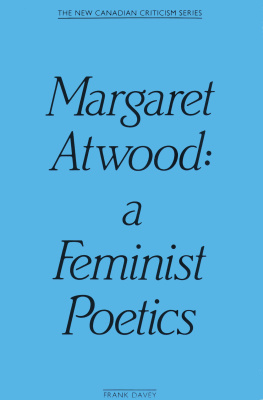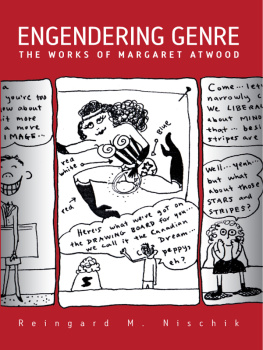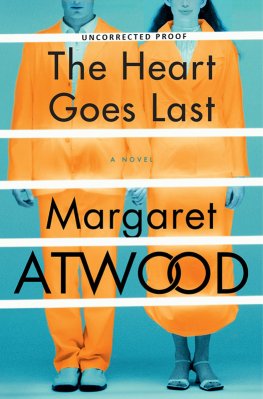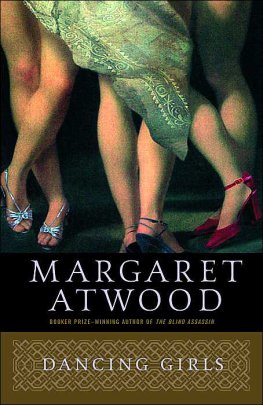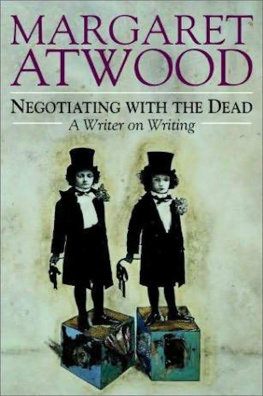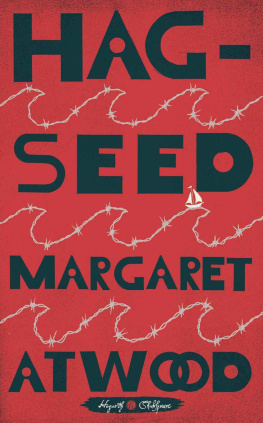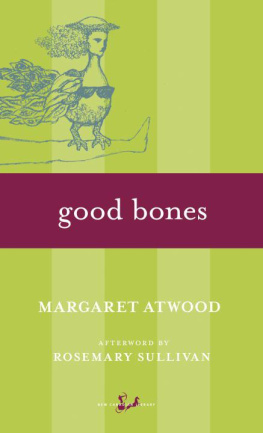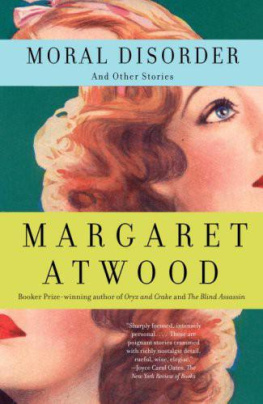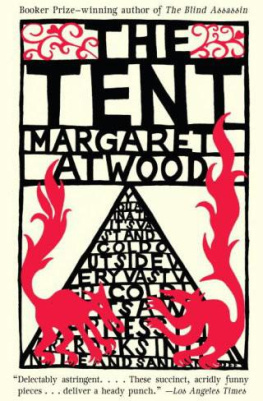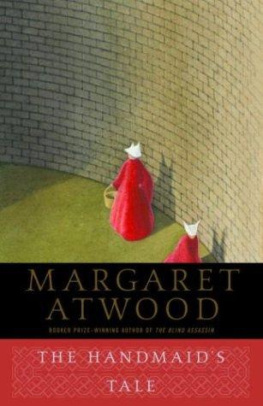Margaret
Atwood:
a
Feminist
Poetics
by Frank Davey

Copyright 1984 Frank Davey
Published with assistance from the Canada Council
Talonbooks
278 East 1st Avenue
Vancouver
British Columbia V5T 1A6
Canada
talonbooks.com
Print edition designed and typeset at The Coach House Press, Toronto
Printed in Canada by Hignell Printing Limited
Second printing: August 1986
Ebook by Talonbooks
CATALOGUING DATA AVAILABLE FROM LIBRARY AND ARCHIVES CANADA
ISBN 978-0-88922880-1
Contents
Abbreviations
Passages from Margaret Atwoods writings have been taken from the following editions:
| AC | The Animals in that Country. Toronto: Oxford University Press, 1968. |
| BE | Bluebeards Egg. Toronto: McClelland and Stewart, 1983. |
| BH | Bodily Harm. Toronto: McClelland and Stewart, 1981. |
| CG | The Circle Game. Toronto: House of Anansi, 1967. |
| DG | Dancing Girls. Toronto: Seal Books, 1977. |
| DP | Double Persephone. Toronto: Hawkshead Press, 1961. |
| EW | The Edible Woman. Toronto: McClelland and Stewart, 1969. |
| I | Interlunar. Toronto: Oxford University Press 1984. |
| JSM | The Journals of Susanna Moodie. Toronto: Oxford University Press, 1970. |
| LO | Lady Oracle. Toronto: McClelland and Stewart,1976. |
| LBM | Life Before Man. Toronto: McClelland and Stewart, 1979. |
| MD | Murder in the Dark. Toronto: The Coach House Press, 1983. |
| PP | Power Politics. Toronto: House of Anansi, 1971. |
| PU | Procedures for Underground. Toronto: Oxford University Press, 1970. |
| TS | True Stories. Toronto: Oxford University Press, 1981. |
| THP | Two-Headed Poems. Toronto: Oxford University Press, 1978. |
| S | Surfacing. Toronto: McClelland and Stewart, 1972.. |
| Su | Survival. Toronto: House of Anansi, 1972,. |
| YAH | You Are Happy. Toronto: Oxford University Press, 1974. |
CHAPTER ONE
An Unneeded Biography
You dont need biographical information unless the work is unintelligible without it. Its most unfortunate that Dorothy Wordsworth kept a diary. I dont care if William Wordsworth ever saw a field of golden daffodils(Margaret Atwood, Interview with Linda Sandier)
MARGARET Atwood was born on the 18th of November, 1939, the second child of Carl Edward Atwood, an entomologist, and Margaret Dorothy Killam. From the time she was six months old until she was eleven, the family spent more than half of each year in the wilderness of Northern Ontario above Temiskaming, where her father conducted research. Atwood describes this period in her article Travels Back:
Highway 17 was my first highway, I travelled along it six months after I was born, from Ottawa to North Bay and then to Temiskaming, and from there over a one-track dirt road into the bush. After that, twice a year, north when the ice went out, south when the snow came, the time between spent in tents; or in the cabin built by my father on a granite point a mile by water from a Quebec village so remote that the road went in only two years before I was born.
From 1939 to 1945 the family wintered in Ottawa; in 1945 in Sault Ste. Marie, and from 1946 to 1951 in Toronto. Although the remoteness of the familys cabin kept Atwood from completing a full year of school until 1950, it also seems to have made both her early reading and her fathers work of special importance to her. The Gothic materials of Power Politics and Lady Oracle, and the motif of miraculous change which recurs in these books as well as in Surfacing, The Edible Woman, and Procedures for Underground, can be linked, as she told Linda Sandier, with her childhood reading.
most fairy tales and religious stories involve miraculous changes of shape. Grimms tales, Greek and Celtic legends, have them. North American Indian legends have people who are animals in one incarnation, or who can take on the shape of a bird at will. I would say that Grimms Fairy Tales was one of the most influential books I ever read.
References to the biological world of her fathers research abound in her work, from the insect-eating sundew and the caterpillars whose metamorphoses form the central images of Surfacing and Lady Oracle to the warm rotting of vegetable flesh in Pre-Amphibian, the immigrants who danced like sandflies in Further Arrivals and the dead dog/jubilant with maggots in The Double Voice. Atwood discusses this influence with Sandier.
My father is an entomologist and he used to bring home these things in one form, they would go through some mysterious process and emerge as something else. So metamorphosis was familiar to me at an early age. Later on I studied chemistry and botany and zoology, and if I hadnt been a writer Id have gone on with that.
The geography north of Temiskaming must have given Atwood special insight into Susanna Moodies life in the 1830s in the bush north of Peterborough, and may have provided almost exactly the lake blue and cool as redemption (S15) at which most of the action of Surfacing occurs. She began writing during these childhood years, producing novels and books of poems among them, a novel about the ant
Novels and books of poems, in which I made the book first and filled in the poems later, I was already into publishing. Then I had a sterile period between the age of 9 and the age of 16
In the early 1950s Atwood attended Leaside High School in Toronto, where she appears to have been remarkably active. She participated in basketball, the United Nations Club, and a school choral group, and earned the schools citizenship award. Although majoring in Home Economics, in 1955 she began
writing borderline literary material that people dont usually associate with me musical comedies, commercial jingles, various things under pseudonyms. I even wrote an opera about synthetic fabrics for my Home Economics class. It was about that time I realized I didnt want to be a home economist, I wanted to be a writer. That was a great change, because I was supposed to be practical and sensible; that was my image.
In her mature writing, this period in Atwoods life appears to be partly metamorphosed into Marian MacAlpin of The EdibleWoman, a competent homemaker who is burdened with a sensible image (EW 89).
Atwood also produced some serious writing during this time prose modeled on that of Edgar Allan Poe Some of this work was published in her schools magazine Clarion Call.
It was not until her second or third year at university that Atwood discovered Canadian writing. She had enrolled at Victoria College, University of Toronto, in 1957, and begun studies under Jay Macpherson, Northrop Frye, Kathleen Coburn, and Millar McClure. Her consequent introduction to Canadian books was decisive.
when I did discover Canadian writing it was a tremendously exciting thing because it meant that people in the country were writing and not only that, they were publishing books. And if they could be publishing books, then so could I. So then I read a lot of stuff, and I was lucky enough to know somebody who had a fairly extensive library of Canadian poetry which I read from beginning to end, so that by the time I was about 211 had certainly found my tradition.

